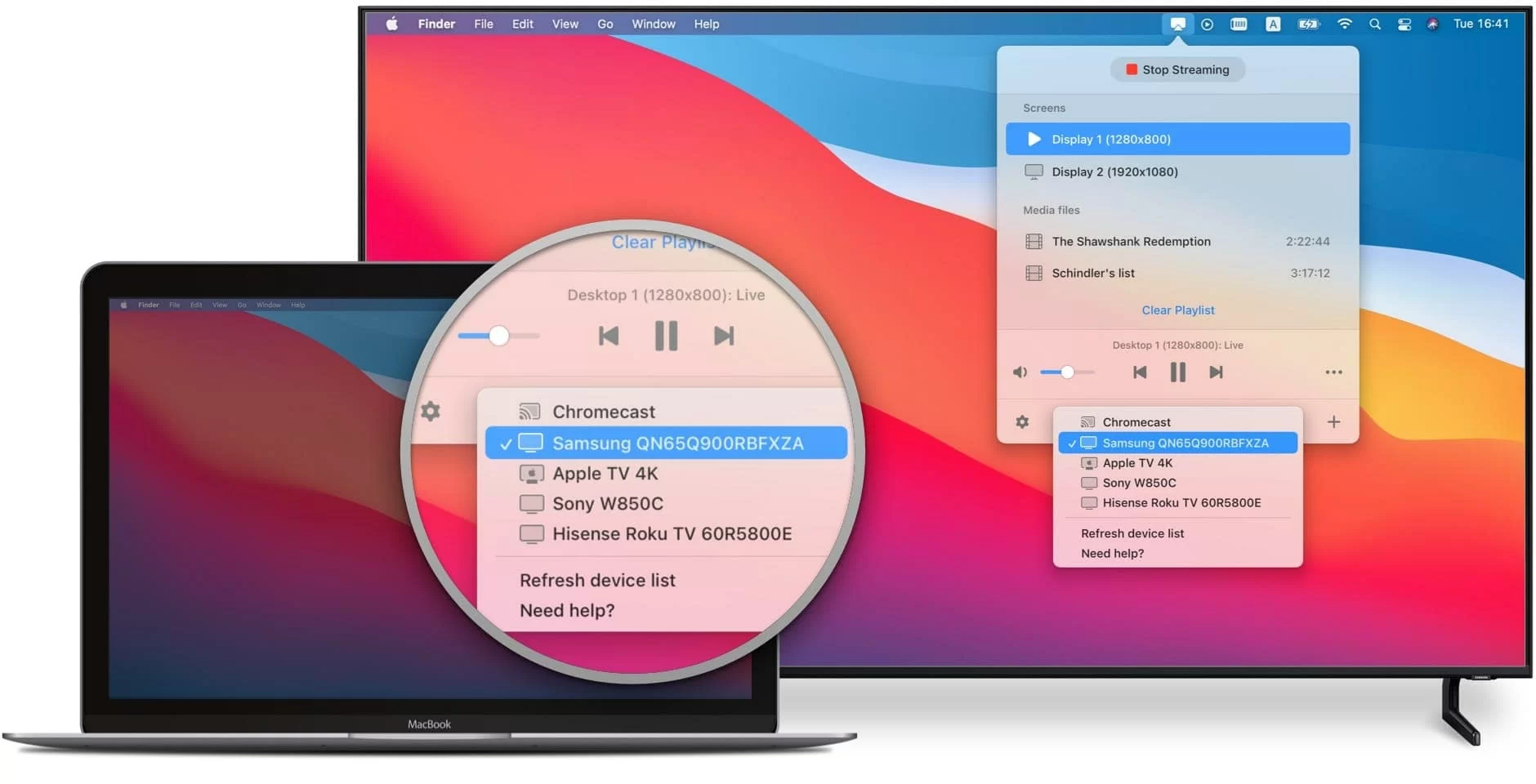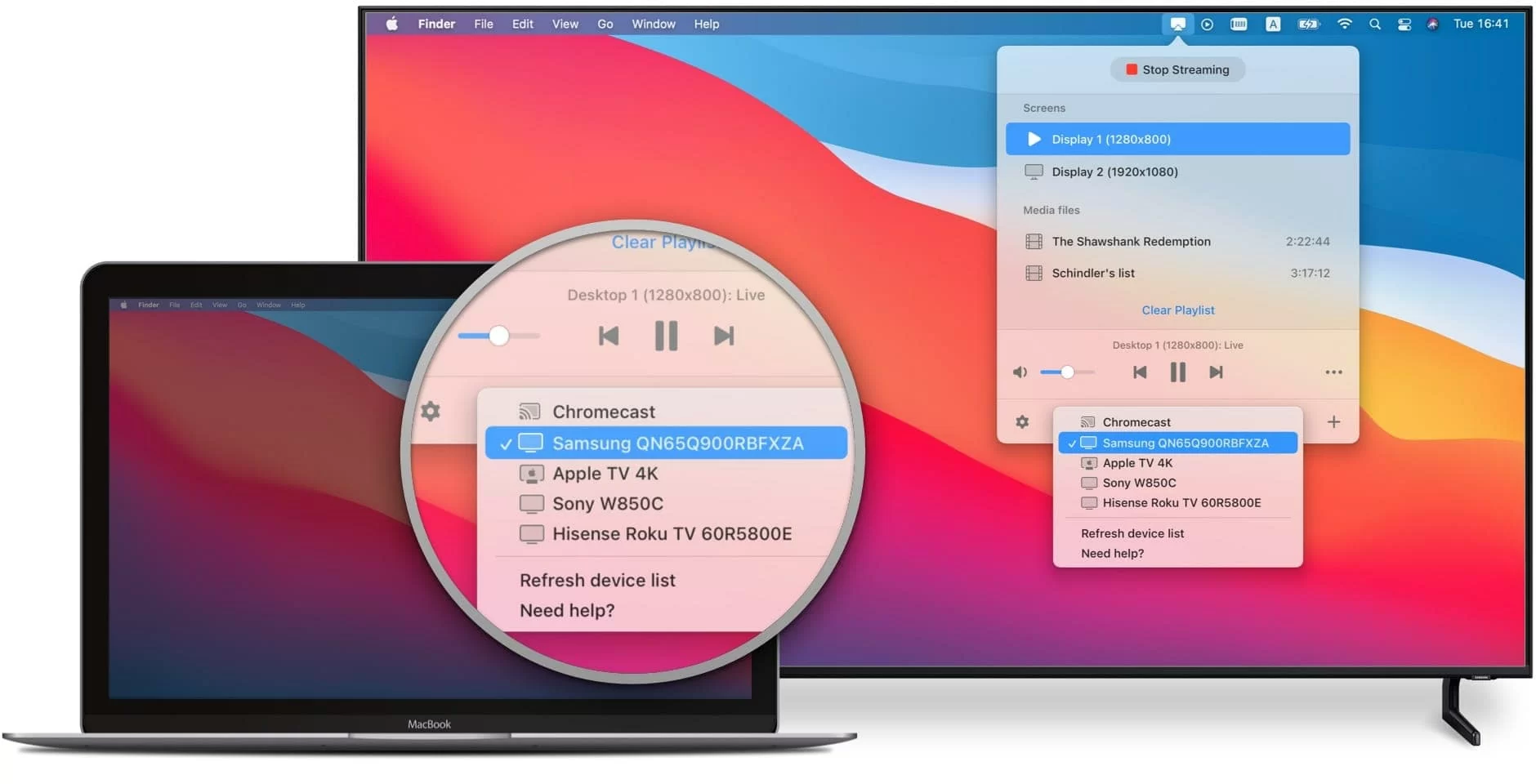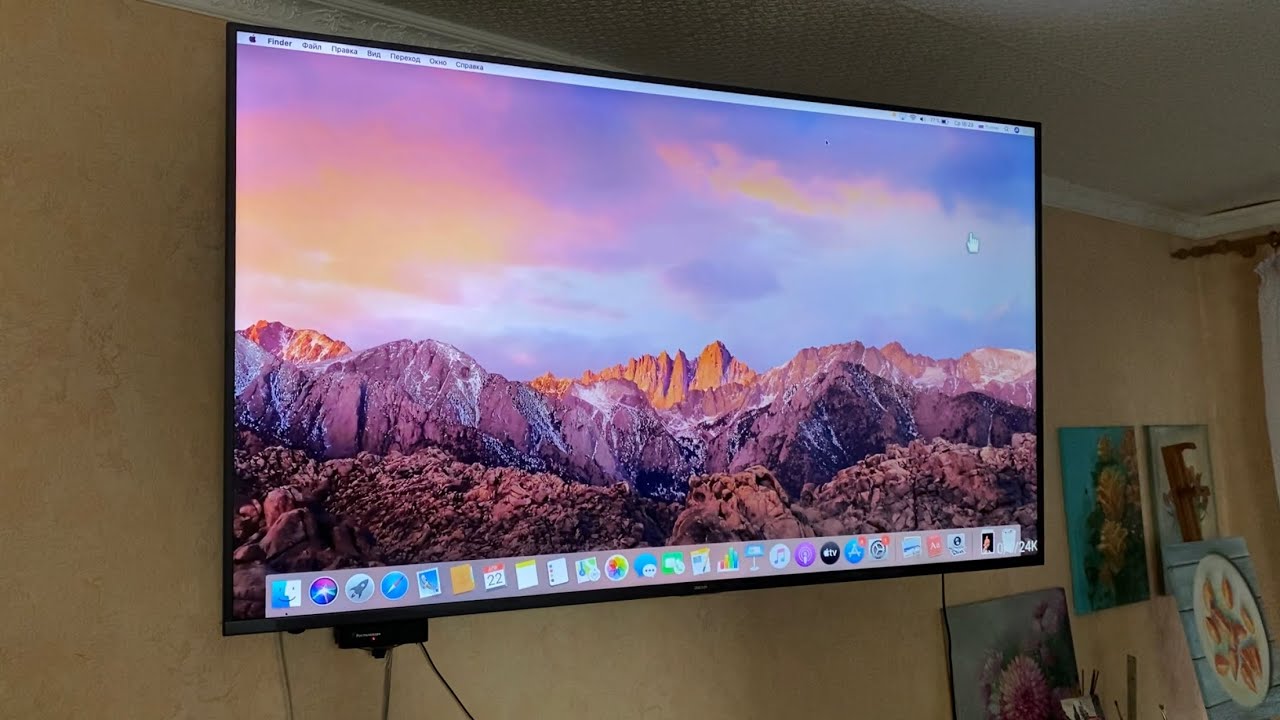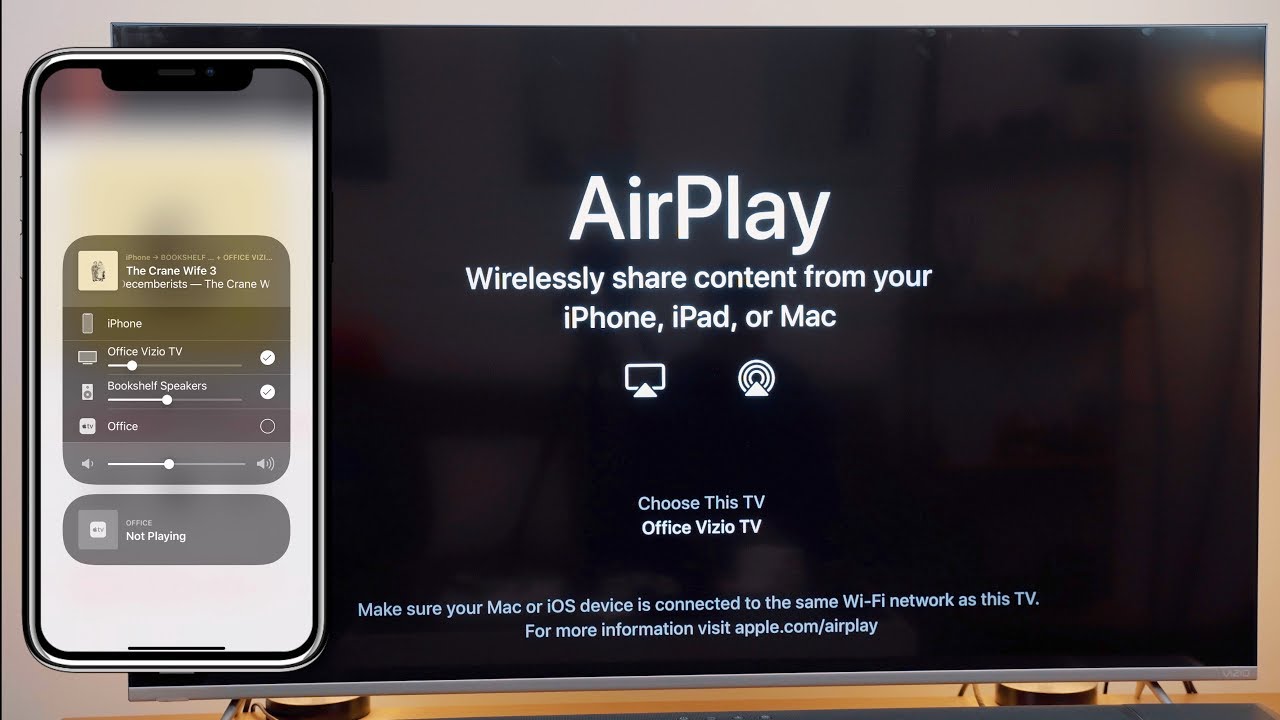Introduction
Welcome to the world of Airplay on your MacBook Pro! Airplay is a fantastic feature that allows you to stream content from your MacBook Pro to other devices, such as televisions, speakers, and even other Macs. Whether you want to enjoy your favorite movies on the big screen or listen to your music collection on a powerful speaker system, Airplay makes it all possible with just a few simple steps.
In this guide, we will walk you through the process of using Airplay on your MacBook Pro. We will cover everything you need to know, from understanding what Airplay is and ensuring compatibility with your device to troubleshooting any issues that may arise along the way. By the end of this guide, you’ll be ready to take full advantage of the Airplay feature and enhance your multimedia experience on your MacBook Pro.
Before we dive into the details, let’s start by explaining what Airplay is and how it can benefit you. Airplay is an Apple technology that enables wireless streaming of audio, video, and other media from your Apple device to compatible devices. It allows you to seamlessly transmit content from your MacBook Pro to a larger screen or a more powerful audio system, eliminating the need for cumbersome cables or connectors.
Whether you’re hosting a movie night, giving a presentation, or simply want to enjoy your favorite content on a bigger screen, Airplay provides a convenient solution. With just a few taps or clicks, you can wirelessly mirror your MacBook Pro’s display or stream media to a compatible device.
Now that you have a basic understanding of what Airplay is, it’s important to ensure that your MacBook Pro is compatible with this feature. Airplay is available on select MacBook Pro models, so make sure your device supports it before proceeding. If you’re not sure, you can check your MacBook Pro’s specifications or consult Apple’s official website to confirm compatibility.
In the next section, we will guide you through the process of checking whether your devices are connected to the same network, which is a crucial step in establishing a stable Airplay connection. So, let’s move forward and get you started with Airplay on your MacBook Pro!
What is Airplay?
Airplay is a wireless streaming technology developed by Apple that allows you to effortlessly transmit audio, video, and other media from your MacBook Pro to compatible devices. Whether you want to share a presentation during a meeting or enjoy your favorite TV show on a larger screen, Airplay offers a convenient and seamless solution.
One of the key features of Airplay is the ability to mirror your MacBook Pro’s screen onto another device, such as an Apple TV or a smart TV with Airplay support. This means you can display everything that appears on your MacBook Pro’s screen, including apps, documents, videos, and more, on a larger display. It’s perfect for giving presentations, playing games, or simply enjoying a more immersive viewing experience.
Additionally, Airplay enables you to stream audio from your MacBook Pro to compatible speakers or audio systems. With just a few clicks, you can wirelessly send your music playlist or podcast to a set of speakers placed in your living room, creating a seamless and immersive audio experience throughout your home.
One of the great advantages of using Airplay is its compatibility with various devices. In addition to Apple TV and smart TVs, Airplay is supported by devices like HomePods, Airplay-enabled speakers, and even other Macs. This means you can create a multi-room audio system by syncing multiple Airplay-enabled speakers or utilize Airplay to stream content from one Mac to another, offering a wide range of possibilities for sharing and enjoying media.
Another noteworthy aspect of Airplay is its ease of use. Apple has designed Airplay to be user-friendly, allowing you to establish a connection between your MacBook Pro and compatible devices with minimal effort. Once connected, you can control the playback, volume, and other settings directly from your MacBook Pro or use the controls on the receiving device, depending on your preferences.
Whether you’re a professional looking to present your work, a home theater enthusiast seeking a wireless streaming solution, or someone who wants to enjoy their music collection throughout their house, Airplay provides a versatile and convenient way to do so. It seamlessly integrates with your MacBook Pro and compatible devices, enhancing your multimedia experience and making it easier than ever to share and enjoy content on a bigger screen or with better audio quality.
In the next section, we will guide you through the process of checking whether your MacBook Pro is compatible with Airplay and ensuring that your devices are connected to the same network. So, let’s dive in and get you ready to start using Airplay on your MacBook Pro!
Compatibility with MacBook Pro
Before you can begin using Airplay on your MacBook Pro, it’s important to ensure that your device is compatible with this feature. Airplay is supported on select MacBook Pro models, so it’s essential to verify compatibility to avoid any frustration or disappointment.
If you’re unsure whether your MacBook Pro supports Airplay, there are a couple of ways to check. One option is to consult the official Apple website or documentation for your MacBook Pro model. Apple provides comprehensive specifications for each device, including information about Airplay compatibility.
Alternatively, you can check your MacBook Pro’s system settings. Here’s how:
- Click on the Apple menu in the top left corner of your screen and select “About This Mac.”
- In the window that appears, click on the “Overview” tab.
- Look for the “MacBook Pro” section, which will display the model and year of your device.
Once you have determined that your MacBook Pro is compatible with Airplay, you can move on to the next step: making sure that your devices are connected to the same network.
For Airplay to work smoothly, both your MacBook Pro and the receiving device need to be connected to the same Wi-Fi network. This is because Airplay relies on a local network connection to transmit data. If your devices are connected to different networks, Airplay will not function properly, and you won’t be able to stream content.
To check if your MacBook Pro and the receiving device are on the same network, follow these steps:
- On your MacBook Pro, click on the Wi-Fi icon in the menu bar at the top right corner of the screen to view the available Wi-Fi networks.
- Select your network from the list and ensure that it is connected.
- On the receiving device, such as an Apple TV or Airplay-enabled speaker, navigate to the network settings and confirm that it is connected to the same Wi-Fi network as your MacBook Pro.
If your devices are connected to different networks, you may need to switch one or both of them to ensure they are on the same network. This may involve adjusting the Wi-Fi settings on your MacBook Pro or configuring the network settings on the receiving device.
By confirming compatibility and verifying that your devices are connected to the same network, you have completed the essential preliminary steps to use Airplay on your MacBook Pro. In the next section, we will guide you through the process of enabling Airplay on your MacBook Pro, so let’s keep the momentum going!
Step 1: Ensure your devices are connected to the same network
Before you can begin using Airplay on your MacBook Pro, it’s crucial to ensure that both your MacBook Pro and the receiving device, such as an Apple TV or Airplay-enabled speaker, are connected to the same Wi-Fi network. This is because Airplay relies on a local network connection to transmit data seamlessly between devices.
To ensure your devices are connected to the same network, follow these steps:
- On your MacBook Pro, click on the Wi-Fi icon in the menu bar at the top right corner of the screen. A dropdown menu will appear, showing the available Wi-Fi networks within range.
- Select the network that you want to connect to. If you’re unsure which network to choose, consult your network administrator or refer to the network name (SSID) provided by your Internet Service Provider (ISP).
- Enter the password for the selected network if prompted. Make sure to enter the correct password to establish a successful connection.
- Wait for your MacBook Pro to connect to the Wi-Fi network. You can verify the connection by checking the Wi-Fi icon in the menu bar, which should show that your MacBook Pro is connected to the selected network.
- Now, ensure that the receiving device, such as an Apple TV or Airplay-enabled speaker, is also connected to the same Wi-Fi network. Use the device’s interface or settings to navigate to the network settings and confirm the connection.
If your MacBook Pro and the receiving device are connected to different networks, you may encounter difficulties when trying to use Airplay. It’s important to troubleshoot and resolve any connectivity issues to ensure a smooth and uninterrupted Airplay experience.
If you’re having trouble connecting either your MacBook Pro or the receiving device to the same Wi-Fi network, here are a few troubleshooting steps you can follow:
- Restart your MacBook Pro and the receiving device, as this can sometimes resolve temporary network issues.
- Move your MacBook Pro and the receiving device closer to the Wi-Fi router to ensure a stronger and more stable Wi-Fi signal.
- Check if there are any firmware updates available for your MacBook Pro or the receiving device. Installing the latest updates can often fix compatibility or connectivity issues.
- If you’re still unable to connect, consult the user manual or contact the manufacturer’s support for both your MacBook Pro and the receiving device for further assistance.
By confirming that your MacBook Pro and the receiving device are connected to the same Wi-Fi network, you have completed the first step in using Airplay. In the next section, we will guide you through enabling Airplay on your MacBook Pro, so let’s move forward!
Step 2: Enable Airplay on your MacBook Pro
Once you have confirmed that your MacBook Pro and the receiving device are connected to the same Wi-Fi network, the next step is to enable Airplay on your MacBook Pro. Enabling Airplay will allow your MacBook Pro to discover and connect to compatible devices for streaming audio, video, and other media.
To enable Airplay on your MacBook Pro, follow these simple steps:
- Click on the Apple menu in the top left corner of your screen.
- Select “System Preferences” from the dropdown menu.
- In the System Preferences window, click on the “Displays” icon.
- Within the Displays menu, you should see a tab labeled “Airplay.” Click on it.
- A list of available Airplay devices will be displayed. Select the device you want to connect to from the list.
After selecting the desired Airplay device, your MacBook Pro will attempt to connect to it. Depending on the device, you may be required to enter a one-time passcode or confirm the connection on both your MacBook Pro and the receiving device.
If the connection is successful, your MacBook Pro’s screen will be mirrored on the receiving device, displaying everything that appears on your MacBook Pro’s display. Alternatively, if you want to stream media to an Airplay-enabled speaker, the audio will be sent to the selected device, providing a high-quality sound experience.
Keep in mind that some devices may have their own Airplay settings that need to be enabled. If you encounter any difficulties during the Airplay setup process, consult the user manual or the manufacturer’s support for the receiving device for specific instructions.
Once you have successfully enabled Airplay on your MacBook Pro and connected to the desired device, you can start enjoying the benefits of wireless streaming. Whether you want to watch movies, share presentations, or listen to music, Airplay allows you to do it effortlessly and conveniently.
In the next section, we will guide you through adjusting Airplay settings and exploring additional features to enhance your Airplay experience. So, let’s proceed to the next step and get the most out of Airplay on your MacBook Pro!
Step 3: Choose the device you want to Airplay to
Now that you have successfully enabled Airplay on your MacBook Pro, it’s time to choose the device you want to Airplay to. Depending on your needs and preferences, you can select from a range of compatible devices, such as an Apple TV, Airplay-enabled speakers, or even another Mac.
To choose the device you want to Airplay to, follow these steps:
- Ensure that both your MacBook Pro and the desired Airplay device are turned on and connected to the same Wi-Fi network.
- In the menu bar at the top of your MacBook Pro’s screen, you should see an Airplay icon. It looks like a rectangle with a triangle at the bottom.
- Click on the Airplay icon, and a dropdown menu will appear, showing a list of available Airplay devices within range.
- Select the device you want to Airplay to from the list. The device may be named after its model or a customized name you have assigned to it.
Once you have selected the desired Airplay device, your MacBook Pro will establish a connection with it and start streaming the audio, video, or other media accordingly. The content will either be mirrored on the device’s screen or played through its speakers, depending on the type of device you have chosen.
It’s worth noting that you can Airplay to multiple devices simultaneously if they are all compatible and connected to the same Wi-Fi network. This feature allows you to create a synchronized audio or video experience in multiple rooms or areas of your home.
Additionally, some Airplay devices may have unique features or settings that can further enhance your experience. For example, certain Airplay-enabled speakers may offer different sound profiles or customizable EQ settings. Explore the documentation or user manual provided with your specific Airplay device to learn more about any additional features or settings available.
If you encounter any difficulties when choosing or connecting to an Airplay device, try the following troubleshooting steps:
- Ensure that the Airplay device is powered on and within range of your MacBook Pro.
- Restart both your MacBook Pro and the Airplay device to refresh their connections.
- Check for any firmware updates available for the Airplay device and install them if necessary.
- Disconnect and reconnect to the Wi-Fi network on both your MacBook Pro and the Airplay device.
By choosing the device you want to Airplay to, you’re ready to start enjoying your favorite content on a bigger screen or with superior audio quality. In the next section, we will guide you through adjusting Airplay settings to customize your streaming experience. So, let’s move forward and make the most out of Airplay on your MacBook Pro!
Step 4: Adjust Airplay settings
After choosing the device you want to Airplay to, you have the option to adjust various settings to customize your Airplay experience on your MacBook Pro. These settings allow you to fine-tune the streaming quality, control playback, and optimize the audio and video output according to your preferences.
Follow these steps to adjust Airplay settings on your MacBook Pro:
- Ensure that your MacBook Pro is still connected to the Airplay device you selected in the previous step.
- Click on the Airplay icon in the menu bar at the top of your screen.
- In the Airplay dropdown menu, you may see different options depending on the device you are connected to.
- Explore the available settings to customize your Airplay experience. Some common options may include adjusting the output volume, selecting the video resolution, or enabling or disabling subtitles.
- Experiment with different settings to find the combination that suits your preferences and provides the best audio and video quality.
Additionally, some apps or media players offer their own Airplay settings that you can access within the app interface. For example, if you are streaming content from a video player, you may have the option to adjust the video aspect ratio, enable closed captions, or control the playback speed directly within the app’s Airplay settings.
It’s important to note that the available Airplay settings may vary depending on the specific device you are connected to and the capabilities of that device.
If you encounter any issues or limitations with the Airplay settings, here are a few troubleshooting steps you can try:
- Disconnect and reconnect your MacBook Pro to the Airplay device to refresh the settings.
- Update the firmware on your Airplay device to ensure compatibility with the latest settings.
- Consult the user manual or contact the manufacturer’s support for your Airplay device for further assistance with settings customization.
By adjusting the Airplay settings on your MacBook Pro, you can optimize your streaming experience to match your preferences and enjoy your content to the fullest. Now that you have successfully adjusted the Airplay settings, you’re all set to start streaming audio, video, and other media wirelessly to your Airplay-enabled devices.
In the next section, we will cover troubleshooting common Airplay issues and provide solutions to help you overcome any challenges you may encounter. So, let’s continue on and ensure a smooth Airplay experience on your MacBook Pro!
Troubleshooting common Airplay issues
While Airplay is generally a convenient and reliable feature, you may occasionally encounter some issues that can disrupt your streaming experience. Understanding and troubleshooting these common Airplay issues can help you overcome them quickly and enjoy uninterrupted multimedia streaming on your MacBook Pro.
Here are some common Airplay issues you may encounter and their potential solutions:
- No devices found: If you cannot see any Airplay devices listed when you click on the Airplay icon, verify that both your MacBook Pro and the Airplay device are connected to the same Wi-Fi network. Restarting your MacBook Pro and the device can also help reestablish the connection.
- Poor streaming quality: If you’re experiencing low-quality video or audio while streaming, make sure your MacBook Pro and the Airplay device have a stable Wi-Fi connection. Moving them closer to the Wi-Fi router or eliminating any physical obstructions can improve the signal strength. Additionally, reducing network congestion by disconnecting other devices from the network may help enhance streaming quality.
- Intermittent connection: If the connection between your MacBook Pro and the Airplay device keeps dropping or is unstable, try restarting your MacBook Pro and the device. If the problem persists, check for any firmware updates for both your MacBook Pro and the Airplay device and install them if available. In some cases, resetting the network settings on your MacBook Pro can also help resolve connection issues.
- Audio and video out of sync: If you notice a delay between audio and video playback, try pausing and then resuming the media. Alternatively, disconnecting and reconnecting to the Airplay device may help sync the audio and video. Adjusting the audio delay or latency settings on the Airplay device, if available, can also help resolve the issue.
- Compatibility issues: If you’re having trouble connecting to a specific Airplay device, check for any specific compatibility requirements or restrictions. Ensure that your MacBook Pro meets the necessary system requirements for Airplay and that the Airplay device supports the version of Airplay you’re using. Updating the firmware on the Airplay device can also help resolve compatibility issues.
If, after following the troubleshooting steps, you still encounter persistent Airplay issues, it may be beneficial to consult the user manual or contact the manufacturer’s support for your MacBook Pro or the Airplay device. They can provide more specific guidance tailored to your particular setup.
By troubleshooting common Airplay issues, you can overcome any challenges that may arise during your streaming sessions. Remember that patience and persistence are essential when dealing with technical issues, and don’t hesitate to reach out for support if needed.
In the next section, we will conclude our guide and summarize the key points we covered throughout this tutorial. So, let’s wrap things up and review what you’ve learned about Airplay on your MacBook Pro!
Conclusion
Congratulations! You have now learned how to harness the power of Airplay on your MacBook Pro. This wireless streaming feature opens up a world of possibilities, allowing you to effortlessly transmit audio, video, and other media to compatible devices.
In this guide, we started by explaining what Airplay is and how it can enhance your multimedia experience. We then ensured that your MacBook Pro is compatible with Airplay and guided you through the crucial step of connecting your devices to the same Wi-Fi network.
Next, we walked you through enabling Airplay on your MacBook Pro and choosing the device you want to Airplay to. You also learned how to adjust Airplay settings to customize your streaming experience and optimize the audio and video quality according to your preferences.
Lastly, we covered troubleshooting common Airplay issues and provided potential solutions to overcome any challenges that may arise during your streaming sessions.
By following the steps outlined in this guide and troubleshooting common issues, you are well-equipped to make the most of Airplay on your MacBook Pro. Whether you want to share presentations, enjoy movies on a big screen, or immerse yourself in high-quality music, Airplay offers a seamless and convenient solution.
Remember to keep your devices connected to the same Wi-Fi network, check for compatibility with Airplay-enabled devices, and explore the various Airplay settings to customize your streaming experience.
If you encounter any difficulties, don’t hesitate to refer back to this guide or seek assistance from the user manual or manufacturer’s support for your MacBook Pro or Airplay devices.
Now that you have mastered Airplay on your MacBook Pro, it’s time to sit back, relax, and enjoy a whole new level of wireless streaming and multimedia entertainment!

























